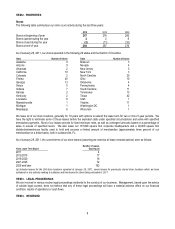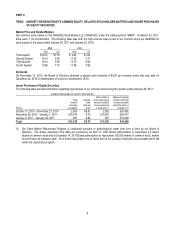Stein Mart 2010 Annual Report Download - page 20
Download and view the complete annual report
Please find page 20 of the 2010 Stein Mart annual report below. You can navigate through the pages in the report by either clicking on the pages listed below, or by using the keyword search tool below to find specific information within the annual report.18
which is considered a significant factor that is difficult to overcome when determining if a valuation allowance is required per ASC
Topic 740, Income Taxes. Although we were profitable in 2009, we remained in a cumulative three-year loss.
In the fourth quarter of 2010, we were no longer in a cumulative three-year loss position because the Company’s income in the last
two years exceeded the loss incurred in 2008. Based on this information, along with our expectations of future earnings, we reversed
our remaining valuation allowance of $6 million in the fourth quarter of 2010. Our valuation allowance also decreased during 2010
due to favorable changes in our net deferred tax asset position related to favorable book/tax differences estimated for 2010. Of the
$16.7 million decrease in our valuation allowance for the year, $14.7 million was recorded in the Consolidated Statements of
Operations. The remainder related primarily to a decrease in deferred tax assets associated with stock based compensation recorded
in prior years for which a tax benefit was not realized. The valuation allowance was $0 and $16.7 million at January 29, 2011 and
January 30, 2010, respectively.
Income Tax Reserves. We record liabilities for uncertain tax positions related to federal and state income taxes. These liabilities
reflect our best estimate of our ultimate income tax liability based on the tax code, regulations, and pronouncements of the
jurisdictions in which we do business. Estimating our ultimate tax liability involves significant judgments regarding the application of
complex tax regulations across many jurisdictions. If actual results differ from estimated results, our effective tax rate and tax
balances could be affected. As such, these estimates may require adjustment in the future as additional facts become known or as
circumstances change.
For a complete listing of our significant accounting policies, see Note 1 of the Notes to Consolidated Financial Statements.
Recent Accounting Pronouncements
In October 2009, the FASB issued guidance impacting the determination of when individual deliverables included in an arrangement
with multiple deliverables may be treated as separate units of accounting. The guidance, which was incorporated into ASC Topic 605,
Revenue Recognition, eliminates the residual method of allocation for multiple-deliverable revenue arrangements, and requires that
arrangement consideration be allocated at the inception of an arrangement to all deliverables using the relative selling price method.
This guidance is effective for fiscal years beginning on or after June 15, 2010, however early adoption is permitted. We will use this
new guidance to account for our Co-Brand Credit Card Consumer Program Agreement. We plan to adopt this guidance in the first
quarter of 2011 and do not anticipate it will have a material effect on our consolidated financial statements.
ITEM 7A. QUANTITATIVE AND QUALITATIVE DISCLOSURES ABOUT MARKET RISK
We are exposed to interest rate risk primarily through borrowings under our revolving credit facility which are at variable rates. The
facility permits debt commitments up to $150 million, has a January 2012 maturity date and bears interest at spreads over the prime
rate and LIBOR. We had no borrowings under our revolving credit facility during 2010.
ITEM 8. FINANCIAL STATEMENTS AND SUPPLEMENTARY DATA
The consolidated financial statements and the Report of Independent Registered Certified Public Accounting Firm thereon are filed
pursuant to this Item 8 and are included in this report beginning on page F-1.
ITEM 9. CHANGES IN AND DISAGREEMENTS WITH ACCOUNTANTS ON ACCOUNTING AND FINANCIAL DISCLOSURE
None.
ITEM 9A. CONTROLS AND PROCEDURES
Evaluation of Disclosure Controls and Procedures
Under the supervision and with the participation of our management, including the Chief Executive Officer and Chief Financial Officer,
we have carried out an evaluation of the effectiveness of the design and operation of our disclosure controls and procedures, as
defined in Rule 13a-15(e) and 15d-15(e) under the Securities Exchange Act of 1934, as amended, as of the end of the period covered
by this report.
No system of controls, no matter how well designed and operated, can provide absolute assurance that the objectives of the system
of controls are met, and no evaluation of controls can provide absolute assurance that the system of controls has operated effectively
in all cases. Our disclosure controls and procedures, however, are designed to provide reasonable assurance that the objectives of
disclosure controls and procedures are met.
Based on the evaluation discussed above, our Chief Executive Officer and Chief Financial Officer have concluded that our disclosure
controls and procedures were effective as of the date of that evaluation to provide reasonable assurance that the objectives of
disclosure controls and procedures are met.
























